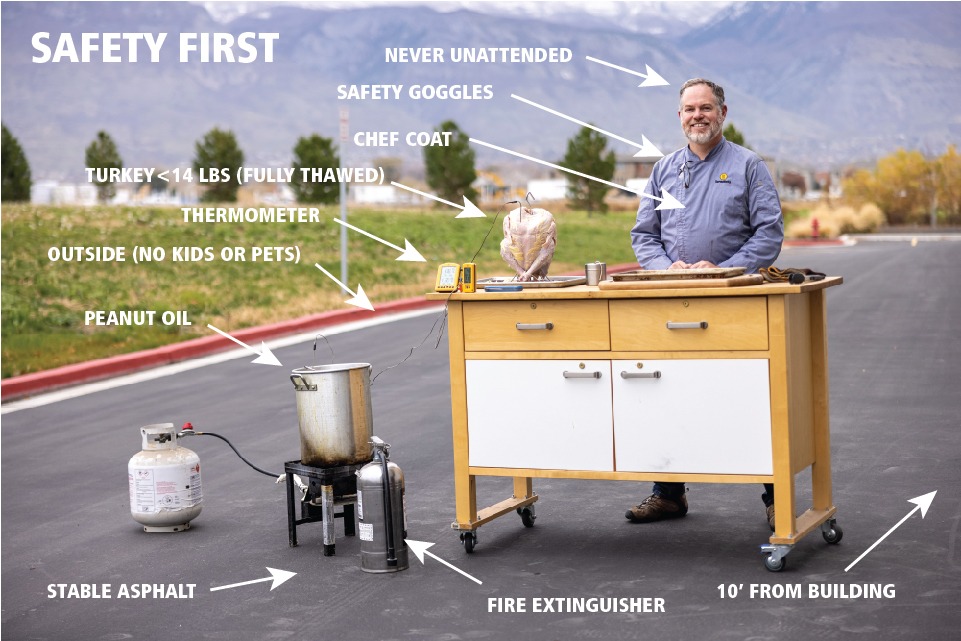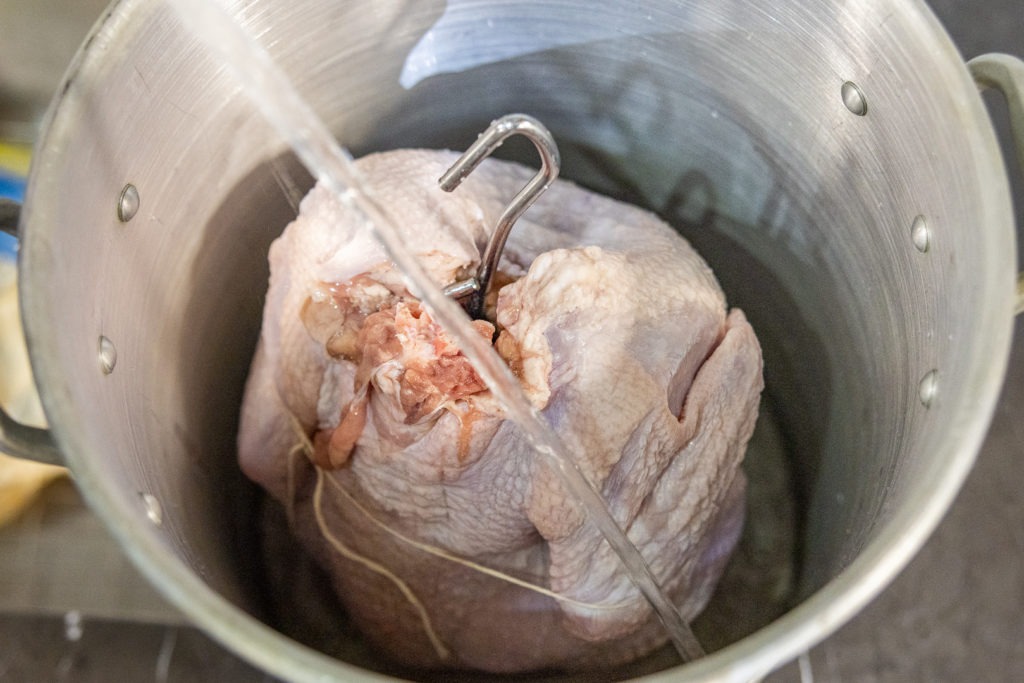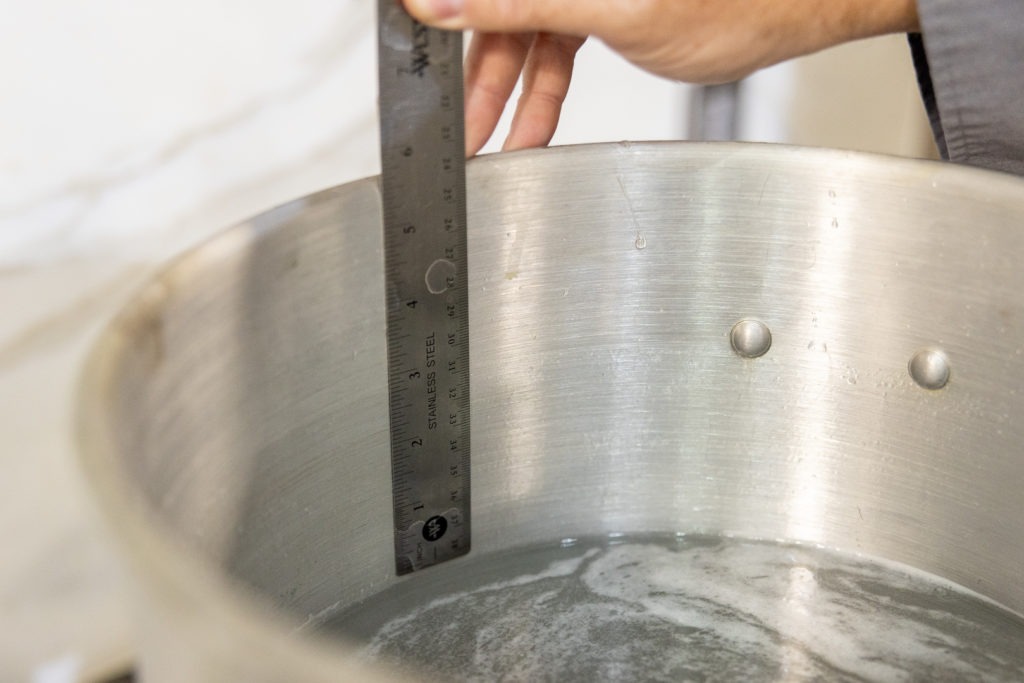Are you in the mood to try something different this year with your Thanksgiving turkey? Why not try deep frying it this year? Some say a fried turkey is the juiciest, most flavorful, crispy-on-the-outside, delicious bit of poultry ever to cross their lips. This project is packed with thermal critical control points that will determine the safety of the cook and the quality of the finished product—and we have all the tips you need.
We’ll be using the ThermoWorks® Smoke X2™ 2-Channel Alarm Thermometer with an additional 12″ Pro-Series® High Temp Probe so we can measure both the turkey meat and the critical oil temperature on the same device.
Deep frying a turkey is a popular cooking method that results in a moist, tender bird with crispy skin Many people wonder if you can deep fry a turkey at 250 degrees Fahrenheit instead of the recommended higher temperature range In this article, we’ll explore whether it’s safe and effective to deep fry a turkey at 250°F.
Overview of Deep Frying Turkey
Deep frying involves fully submerging the turkey in hot oil to cook it. The high heat quickly sears the outside, sealing in juices while cooking the inside. Here are some key points about deep frying turkey
-
The optimal oil temperature is 350-375°F. This ensures the turkey cooks thoroughly and develops a crispy exterior.
-
Only deep fry small to medium turkeys up to 12-15 lbs. Larger birds can be dangerous if the oil overflows.
-
Use a sturdy propane turkey fryer with a wide, tall pot and a basket to lower the turkey into the pot. Never deep fry indoors.
-
Peanut oil is the best choice as it has a high smoke point and neutral flavor. Fill pot with enough oil to submerge turkey.
-
Allow about 3-5 minutes per pound for cooking time. Monitor oil temp and internal temp.
Dangers of Low-Temperature Deep Frying
Heating the oil to the proper temperature is critical for even cooking and safety. Here are some risks of deep frying at 250°F instead of 350-375°F:
-
Longer cooking time means more opportunity for something to go wrong. Oil could overflow or catch fire if overheated to speed up cooking.
-
Turkey may not reach a safe internal temperature of 165°F needed to kill bacteria. Partial cooking at low temps promotes bacterial growth.
-
Skin will likely be pale, soggy, and greasy instead of browned and crispy.
-
Meat near bones may be undercooked while outer areas are overcooked. Results in uneven, poor quality meat.
-
Oil is more likely to break down, smoke, foam, and go rancid at prolonged lower temps. This impacts flavor.
Is Deep Frying a Turkey at 250°F Possible?
While not recommended, it is possible to deep fry a turkey at 250°F. Here’s what to expect:
-
It will take about twice as long to fully cook the turkey compared to frying at 350°F.
-
Oil temperature will drop significantly when turkey is lowered in, then slowly climb back up. It likely won’t reach ideal temp.
-
Flip and rotate turkey frequently to promote even cooking. Monitor breast and thigh temp.
-
End result will be an unevenly cooked turkey with unappealing skin and meat texture. Flavor can be negatively impacted.
-
You’ll need to closely monitor the oil temperature to prevent it from continuing to rise after cooking finishes.
Tips for Deep Frying Turkey at Proper Temp
For best results, deep fry your turkey at the ideal oil temperature of 350-375°F. Here are some tips:
-
Use a thermometer to monitor oil temp. Turn off burner once it reaches temperature before lowering turkey.
-
Pre-heat oil to 375°F, then lower heat to 350°F right before adding turkey. This helps combat temp drop.
-
Fry turkey for 3-5 minutes per pound until breast is 165°F and thighs are 175°F. Time varies by size.
-
Monitor oil temp throughout cooking. Adjust heat gradually to maintain oil in 325-375°F range.
-
If oil temp drops below 300°F, increase heat; if over 375°F, turn off burner temporarily.
-
Let turkey drain well before serving for crispest skin. Enjoy immediately for juicy meat!
Deep frying a turkey at the correct high temperature ensures it cooks properly all the way through. While possible to deep fry at a lower temperature like 250°F, it is not recommended for food safety and quality reasons. For the best shot at fried turkey success, aim for an oil temperature around 350-375°F. Monitor it closely and adjust the heat accordingly for perfect results.

Why fry a turkey?
Deep frying your holiday bird will take less time than roasting does. Most turkeys take about 3 minutes per pound to fry. For example, a 14-pound turkey will take about 42 minutes to cook. While your turkey is cooking outside, the oven will be available for baking rolls, pies, and side dishes.
Frying a whole turkey in hot oil can be dangerous, and caution must be observed. Thousands of fires and injuries occur every year due to turkey fryer fires. Hot oil is highly combustible, and the pot of hot oil will be sitting directly over an open flame. Follow these important tips to ensure the safety of your cook.
- Keep a dry-powder, multipurpose fire extinguisher handy at all times. Never use water to put out a grease fire, it will cause the hot oil to spatter, thereby spreading the fire rapidly.
- Take it outside. Set up the turkey fryer more than 10 feet away from your home, covered patio, roof overhangs, and any other building.
- Set up the burner on stable ground, concrete, or asphalt. Not a wood deck.
- Keep fryer away from children and pets.
- Never leave the setup unattended. Stay within a 10-foot perimeter of the hot oil at all times.
- Don’t drink and fry. The process requires full, focused attention.
- Use a thermometer. Temperature control is crucial. Do not allow the oil to exceed 350°F (177°C).
- Thaw turkey completely. The dramatic temperature difference between a frozen turkey and the hot oil will cause furious bubbling and spillage. If oil spills over the pot it can start a fire, cause an explosion, and result in injury and property damage.
- Pat the turkey completely dry with paper towels. Water on the surface will splatter when lowering the turkey. Splatters cause grease fires.
- Turn off the gas completely when filling the pot with oil, lowering the turkey into the hot oil, lifting the turkey out of the oil, or when removing the pot full of oil from the burner.
- Wear an apron or chef jacket, safety goggles, and use heavy duty elbow-length gloves.

How Much Oil Will I Need?
Too much oil in the pot will cause the oil to bubble and spill over the sides of the pot when the turkey is lowered in—and this is a dangerous fire hazard. Using enough oil and no more is an important safety precaution.


Place the turkey (set on the stand if using) into the empty pot and fill with water until the turkey is covered. Remove the turkey and measure with a ruler the distance from the top level of the pot to the top level of the water. This will be the mark to which the pot needs to be filled with oil.
How to Deep Fry a Whole Turkey – Step by Step Tutorial by @BigPaulOnTheGrill
FAQ
How long does it take to deep fry a turkey at 250 degrees?
Fry for about 45 minutes and remove turkey from oil and check the internal temperature. Turkey is done when an instant-read thermometer inserted into the thickest part of the thigh registers 151 degrees F.
Is it safe to cook a turkey at 250 degrees?
Cooking a turkey overnight at 250 degrees is safe if you follow essential guidelines and prioritize food safety.
What is the lowest temperature you can fry a turkey at?
Start with oil heated to 250°F (121°C), slowly lower the bird, then increase the oil temperature to 325-350°F (163-177°C)—do not exceed 350°F (177°C).
